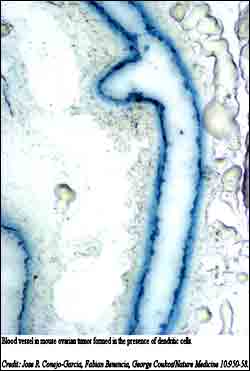Advances in tumor angiogenesis – Dendritic cells co-opted to the dark side

Immune cells transform into blood-vessel cells in ovarian cancer
Researchers at the University of Pennsylvania School of Medicine discovered that in ovarian cancer immune cells can change into blood-vessel cells, and eventually promote the life-sustaining vasculature of the tumor. These findings were initially observed in a mouse model of ovarian cancer that the investigators generated and then confirmed in human ovarian cancer. This work may lead to new approaches to fighting solid tumors.
George Coukos, MD, PhD, and his team, Jose Conejo-Garcia, MD, PhD, and Fabian Benencia, PhD, all investigators in the Abramson Cancer Center and the Center for Research in Women’s Health and Reproduction, report their findings in this week’s online publication and the September issue of Nature Medicine.
“These results clearly deal with ovarian cancer, but we think that the concept is applicable to solid tumors in general,” says Coukos. Ovarian cancer is the leading killer among gynecologic cancers, causing about 25,000 new cases a year and about 15,000 deaths annually in the U.S. “One of the problems is that it’s diagnosed late and we don’t have effective treatments for it.
“Dendritic cells play a central role in the generation of antitumor immune response,” says Coukos. “As a result, it was believed that these were mostly good players in inducing tumor rejection.” But when dendritic cells are part of the tumor microenvironment, instead of stimulating an immune response, they deviate from the program and are co-opted into tumor angiogenesis. “When the dendritic cell precursors are put in the tumor context they form blood vessels that are functional,” notes Conejo-Garcia. In a mouse model in which ovarian tumors expressed high amounts of the proteins beta-defensin and VEGF-A, dendritic cell precursors were attracted to the tumor, where they turned into an endothelial-like cell type. Endothelial cells are the cells forming the inner lining of blood vessels. They are critical for building tumor blood vessels and promoting tumor growth.
For tumors to survive there needs to be a balance between factors that promote tumor growth such as angiogenesis and factors that control tumor growth such as immune response. Researchers have always considered these as two separate systems. “The breakthrough that this work provides is that there is indeed a tremendous interaction between these processes,” says Coukos.
VEGF-A is the key for the transformation of dendritic cells, according to this study. VEGF proteins are ligands produced in the tumor that induce survival and proliferation of endothelial cells. When VEGF-A is overexpressed in tumors, dendritic cells change into endothelial cells, but in the absence of high VEGF-A levels or when VEGF-A is inhibited, the tendency of dendritic cells to convert is reversed. “I think what is fascinating in terms of biology is the plasticity that this cell has depending on its microenvironment,” says Benencia.
It is well established that VEGF-A is the master switch for tumor angiogenesis, with a dose-dependent effect: in this case, dendritic cells were converted into endothelial-like cells only in the presence of high VEGF-A levels. “The levels of VEGF-A generated in our animal model of ovarian cancer resemble those seen in human ovarian cancer,” says Coukos. “We have recapitulated what happens in human tumors.” Thus, VEGF promotes tumor growth not only through angiogenesis but also through suppression of antitumor immune response, because these dendritic cells lose their ability to induce tumor rejection, which in turn may explain why some tumors are tolerated immunologically.
“We are the first to show that dendritic cell precursors in tumors build blood vessels,” says Coukos. “This has previously been seen in vitro, where others have shown that monocytes or dendritic cells can turn into something that looks like endothelial cells, but no one has been able to demonstrate that this could happen in vivo and show its contribution to pathology and physiology.”
The work has also revealed that the bone marrow – via dendritic cell precursors, which are produced in the marrow – is involved in angiogenesis. This observation raises clinically important questions as to the effects of supporting the bone marrow with growth factors during chemotherapy. Dendritic cells have surface molecules called CCR6, which are receptors for beta defensins and other molecules with chemoattracting properties. The team discovered that beta-defensins produced by the tumor attract dendritic cells to the tumor and thus contribute to angiogenesis. The team injected an antibody to CCR6 with an attached toxin that inactivates ribosomes. The toxin is internalized only by cells expressing CCR6, ultimately resulting in cell death. Selective killing of CCR6-expressing cells led tumors to shrink. “This has opened a door to a new therapeutic approach, which was not envisioned before,” says Coukos.
Media Contact
More Information:
http://www.upenn.eduAll latest news from the category: Life Sciences and Chemistry
Articles and reports from the Life Sciences and chemistry area deal with applied and basic research into modern biology, chemistry and human medicine.
Valuable information can be found on a range of life sciences fields including bacteriology, biochemistry, bionics, bioinformatics, biophysics, biotechnology, genetics, geobotany, human biology, marine biology, microbiology, molecular biology, cellular biology, zoology, bioinorganic chemistry, microchemistry and environmental chemistry.
Newest articles

Parallel Paths: Understanding Malaria Resistance in Chimpanzees and Humans
The closest relatives of humans adapt genetically to habitats and infections Survival of the Fittest: Genetic Adaptations Uncovered in Chimpanzees Görlitz, 10.01.2025. Chimpanzees have genetic adaptations that help them survive…

You are What You Eat—Stanford Study Links Fiber to Anti-Cancer Gene Modulation
The Fiber Gap: A Growing Concern in American Diets Fiber is well known to be an important part of a healthy diet, yet less than 10% of Americans eat the minimum recommended…

Trust Your Gut—RNA-Protein Discovery for Better Immunity
HIRI researchers uncover control mechanisms of polysaccharide utilization in Bacteroides thetaiotaomicron. Researchers at the Helmholtz Institute for RNA-based Infection Research (HIRI) and the Julius-Maximilians-Universität (JMU) in Würzburg have identified a…



